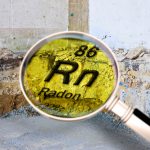What Can Cause Radon to Enter Your Home?
October 27, 2023 5:51 pm Leave your thoughts
In this blog post, we will explore various factors that can cause radon to enter your home. Understanding these factors is crucial because it will help you identify potential sources of radon and take necessary steps to reduce its presence in your living space.
1. Soil Composition and Geology
The first factor that affects radon levels in your home is the composition of the soil and the underlying geology. Certain types of soil and rocks contain higher levels of uranium, which increases the likelihood of radon seepage. For example, homes built on granite or shale bedrock are more susceptible to radon infiltration than those built on sand or clay.
2. Foundation Cracks and Openings
Another common entry point for radon is cracks, gaps, or openings in the foundation of your home. These can occur due to settling of the structure, temperature changes, or natural wear and tear over time. Radon gas can easily seep in through these openings and accumulate to high levels. It is important to regularly inspect your foundation for any signs of damage and seal any cracks to prevent radon infiltration.
3. Construction Materials
Certain types of construction materials can also contribute to radon entry. For instance, homes with concrete blocks or hollow-core concrete slabs are more susceptible to radon penetration. This is because these materials can have small pores or gaps that allow the gas to pass through. If you suspect that your home’s construction materials may be contributing to radon infiltration, it is advisable to consult a professional to assess and address the issue.
4. Well Water
Radon can also enter your home through well water. Groundwater sources, such as private wells, can naturally contain radon. When water is used for bathing, cooking, or cleaning, radon can be released into the air, increasing indoor radon levels. It is important to test your well water for radon and implement appropriate treatment measures if necessary.
5. Home Ventilation
Proper ventilation is essential for maintaining good indoor air quality. However, inadequate ventilation can exacerbate radon levels in your home. When homes are tightly sealed to conserve energy, radon can accumulate indoors. It is important to strike a balance between energy efficiency and maintaining adequate ventilation to reduce radon levels. Utilizing natural ventilation methods, such as opening windows, and installing mechanical ventilation systems can help mitigate radon infiltration.
6. Climate and Seasonal Variations
Radon levels can also vary depending on the climate and seasonal changes. In colder months, homes tend to be more tightly sealed to retain heat, which can lead to higher indoor radon concentrations. Additionally, temperature fluctuations and changes in air pressure can influence radon entry points. It is important to be aware of these variations and consider testing for radon periodically to ensure your home remains safe.
Summary
Several factors can contribute to the entry of radon into your home. Understanding these factors and taking necessary precautions can help you minimize radon levels and protect your family’s health. Regular testing and appropriate remediation measures, such as sealing foundation cracks and improving ventilation, are key in reducing radon exposure. If you suspect radon infiltration, it is recommended to seek professional assistance to accurately assess and address the issue. Remember, prevention is always better than cure when it comes to indoor radon exposure.
Working With HealthSafe Inspections, Inc.
Categorised in: Radon
This post was written by admin
